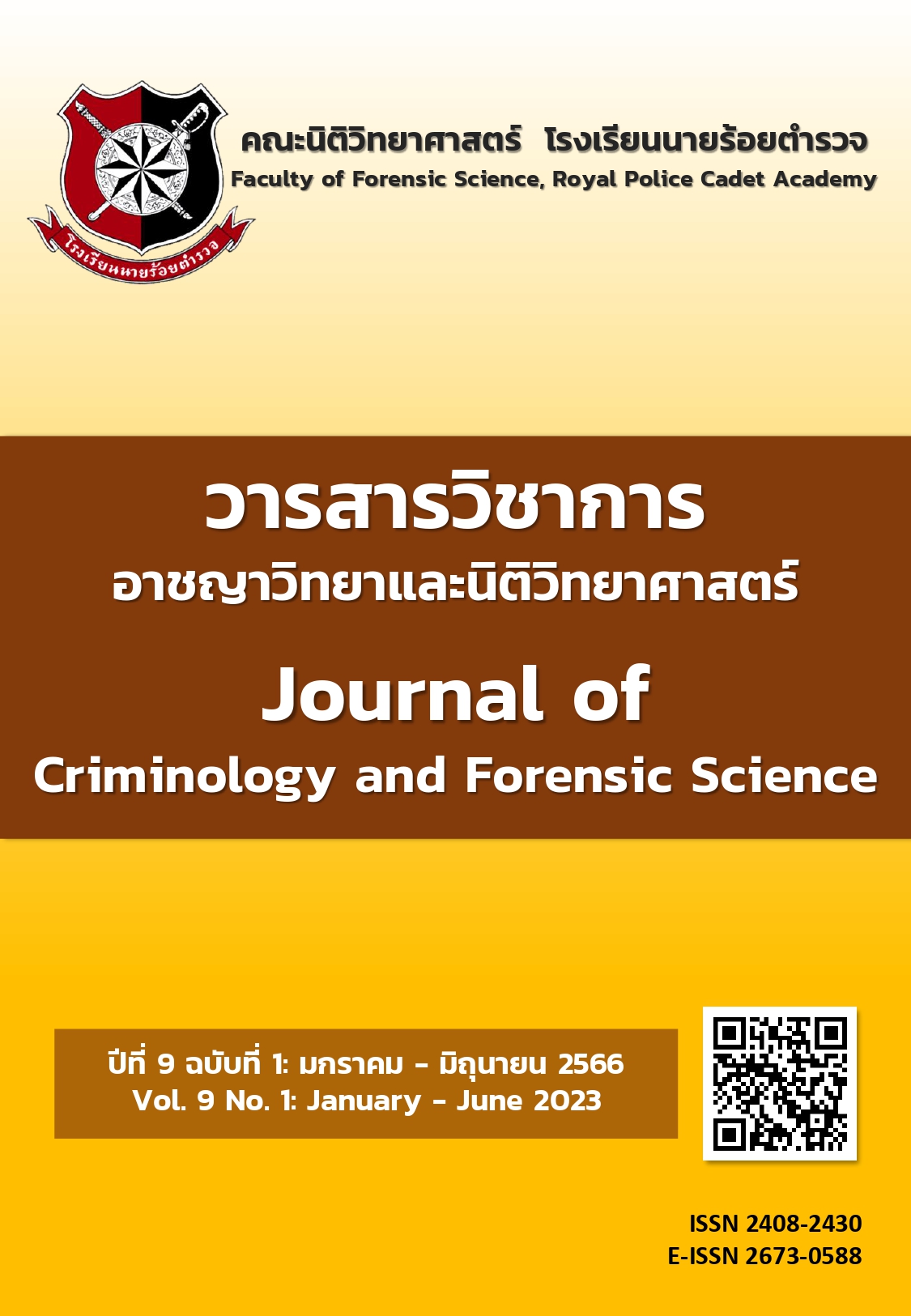การวิเคราะห์ทางนิติวิทยาศาสตร์ของตัวอย่างดินโดยใช้เทคนิคเอกซเรย์ฟลูออเรสเซนซ์แบบกระจายพลังงาน
Main Article Content
บทคัดย่อ
งานวิจัยครั้งนี้มีวัตถุประสงค์เพื่อศึกษาธาตุในตัวอย่างดิน พร้อมเปรียบเทียบลักษณะเฉพาะของแหล่งที่มาของดินกับตัวอย่างดิน โดยทำการศึกษากลุ่มชุดดิน 5 กลุ่ม ภายในจังหวัดสุรินทร์ ได้แก่ กลุ่มชุดดินที่ 17 ต.สลักได กลุ่มชุดดินที่ 33 ต.สวาย กลุ่มชุดดินที่ 22 ต.เพี้ยราม กลุ่มชุดดินที่ 38 ต.คอโค และกลุ่มชุดดินที่ 40 ต.ตาอ็อง โดยนำตัวอย่างดินจากกลุ่มชุดดินดังกล่าวมาวิเคราะห์ด้วยเทคนิคเอกซเรย์ฟลูออเรสเซนซ์แบบกระจายพลังงาน ผลการวิเคราะห์พบว่า มีธาตุทั้งหมด 9 ธาตุ โดยทุกชุดดินจะพบธาตุธาตุซิลิคอน (Si) ธาตุเหล็ก (Fe) ธาตุไทเทเนียม (Ti) และธาตุเซอร์โคเนียม (Zr) เมื่อนำผลการทดลองมาทำการเปรียบเทียบปริมาณของธาตุแต่ละชนิดในตัวอย่างดิน ด้วยวิธี ตัวสถิติทดสอบพิสัยพหุคูณใหม่ของดันแคน (Duncan’s New Multiple Range Test DMRT) ที่ระดับความเชื่อมั่น 95 เปอร์เซ็นต์ พบว่าปริมาณของธาตุในตัวอย่างดินแต่ละชุด มีปริมาณแตกต่างกันอย่างมีนัยสำคัญทางสถิติ จากนั้นทำการเปรียบเทียบปริมาณของธาตุที่พบในกลุ่มชุดดินต่าง ๆ กับกลุ่มชุดดินที่มาจากพื้นรองเท้า ด้วยวิธี ทีเทส (T-Test) จากผลการทดลองพบว่า ค่าเฉลี่ยของปริมาณธาตุในกลุ่มชุดดินต่าง ๆ กับกลุ่มชุดดินที่มาจากพื้นรองเท้า ไม่แตกต่างกันอย่างมีนัยสำคัญทางสถิติ ดังนั้นการวิเคราะห์นี้สามารถใช้ควบคู่กับหลักฐานอื่นที่เกี่ยวข้องกับการสืบสวน เพื่อเชื่อมโยงผู้ต้องสงสัยไปยังสถานที่ที่น่าสนใจได้
Article Details

อนุญาตภายใต้เงื่อนไข Creative Commons Attribution-NonCommercial-NoDerivatives 4.0 International License.
เนื้อหาและข้อมูลในบทความที่ลงตีพิมพ์ใน วารสารวิชาการอาชญาวิทยาและนิติวิทยาศาสตร์ โรงเรียนนายร้อยตำรวจ ถิอว่าเป็นข้อคิดเห็นและความรั้บผิดชอบของผู้เขียนบทความโดยตรงซึ่งกองบรรณาธิการวารสาร ไม่จำเป็นต้องเห็นด้วยหรือรับผิดชอบใดๆ
บทความ ข้อมูล เนื้อหา รูปภาพ ฯลฯ ที่ได้รับการตีพิมพ์ใน วารสารวิชาการอาชญาวิทยาและนิติวิทยาศาสตร์ ถือว่าเป็นลิขสิทธิ์ของวารสาร วารสารวิชาการอาชญาวิทยาและนิติวิทยาศาสตร์ หากบุคคลหรือหน่วยงานใดต้องการนำทั้งหมดหรือส่วนหนึ่งส่วนใดไปเผยแพร่ต่อหรือเพื่อกระทำการใดๆ จะต้องได้รับอนุญาตเป็นลายลักษณ์อักษรจาก วารสารวิชาการอาชญาวิทยาและนิติวิทยาศาสตร์ ก่อนเท่านั้น
เอกสารอ้างอิง
Fuller, J., (2015). Locard's Exchange Principle – How stuff works. Retrieved May 6, 2020. From https://science.howstuffworks.com/locards-exchange-principle1.htm
Land Development Department. (2015) LDD Soil Guide. Retrieved May 6, 2020. From http://www1.ldd.go.th/th-TH/LDD-Soil-Guide/. (In Thai).
Land Development Department. (n.d.). Land Use. Retrieved May 3, 2020. From http://oss101.ldd.go.th/web_soils_for_youth/s_map2.htm. (In Thai).
Makul, S. (2014). Forensic Analysis of Soil Samples by The X-ray Diffraction (XRD) Method. Master of Science Program in Forensic Science Thesis, Silpakorn University, Nakhon Pathom. (In Thai).
National Agricultural Big Data Center. (2020). Soil groups. Retrieved May 3, 2020. From https://nabc-catalog.oae.go.th/dataset/ldd0003. (In Thai).
National Statistical Offic. (2019). The arrest statistics report the number of arrests made. Retrieved May 6, 2020. From https://bit.ly/3LvE9ia. (In Thai).
Sieangsung, S., & Supreyasunthorn, K. (2015). The Admissibility of Forensic Evidence in The Criminal Case of Thailand : A Case Study Especial Biological Evidence Follows Judgment of The Supreme Court. Kasetsart university annual conference of Humanities and Social Sciences. February 3-5, 2015. Bangkok. (In Thai).
Singh, V. and Agrawal, H.M. (2012). Qualitative Soil Mineral Analysis by EDXRF, XRD and AAS Probes. Radiation Physics and Chemistry, 12(81), 1796-1803.
Srethong, J. (2008). Identification of Soil Unique Properties as Accessory Evidence for Forensic Science. Master of Science Thesis, Prince of Songkla University, Songkla. (In Thai).
Uitdehaag, S., Wiarda, W., Donders, T.and Kuiper I. (2016). Forensic Comparison of Soil Samples Using Nondestructive Elemental Analysis. The Journal of Forensic Sciences, 4(62), 861-868.
Vanhoof C, Corthouts V, Tirez K. (2004). Energy-dispersive X-ray fluorescence systems as analytical tool for assessment of contaminated soils. Environmental Monitoring, 6, 344–350.
Wongsang, N. (2018). Energy Dispersive X-ray Fluorescence Spectrometer. Retrieved May 10, 2020. from https://ubu.ac.th/web/files_up/00048f2020041707435257.pdf. (In Thai).


